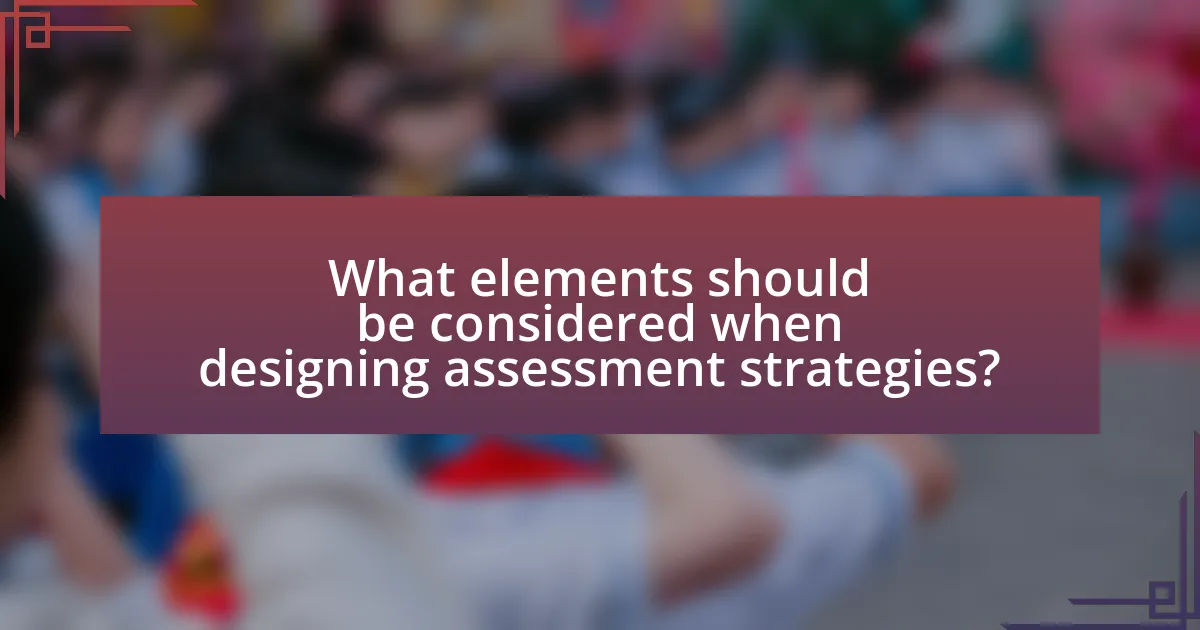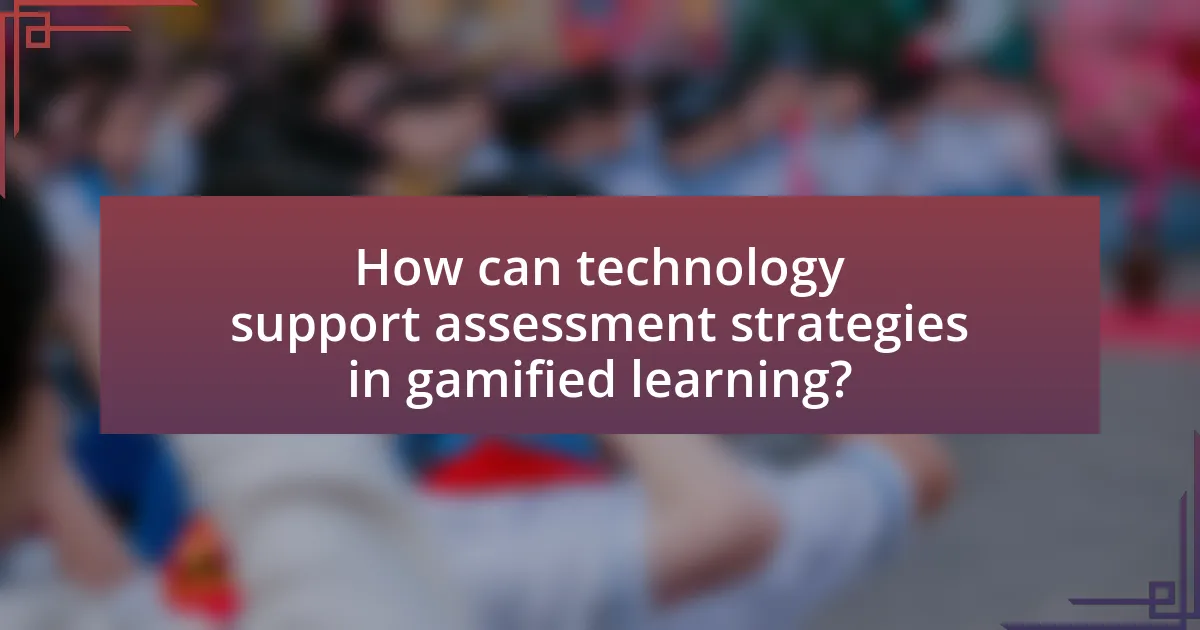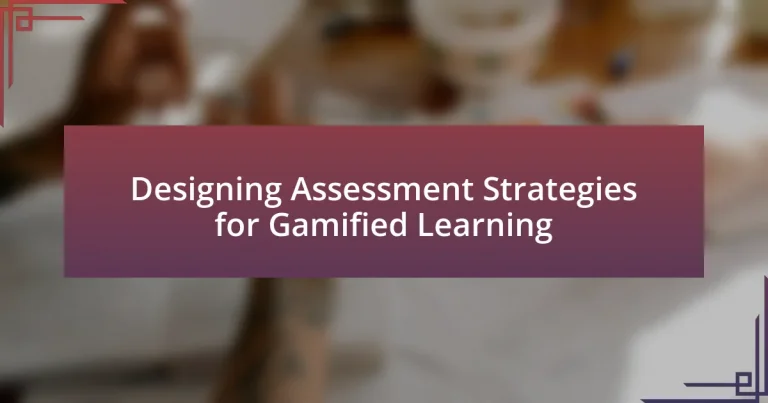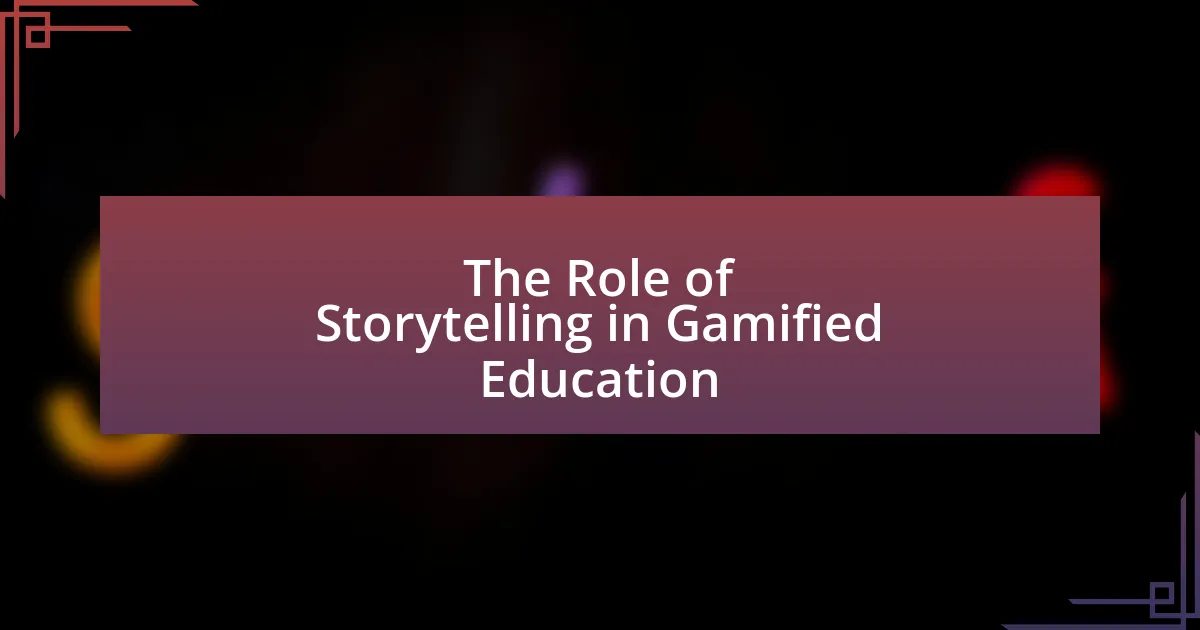Assessment strategies in gamified learning are essential methods for evaluating learners’ progress and understanding within game-based educational environments. This article explores various types of assessments, including formative and summative assessments, and their impact on learner engagement and motivation. It highlights the importance of aligning assessments with learning objectives and incorporating game mechanics to enhance the educational experience. Additionally, the article discusses the role of technology and data analytics in supporting effective assessment strategies, as well as best practices for designing assessments that foster a productive learning environment.

What are Assessment Strategies in Gamified Learning?
Assessment strategies in gamified learning are methods used to evaluate learners’ progress and understanding within a game-based educational environment. These strategies often include formative assessments, such as quizzes and challenges that provide immediate feedback, and summative assessments, like final projects or tests that measure overall learning outcomes. Research indicates that incorporating game mechanics, such as points, badges, and leaderboards, can enhance motivation and engagement, leading to improved learning outcomes. For instance, a study by Hamari et al. (2016) found that gamification positively affects user engagement and learning performance, demonstrating the effectiveness of these assessment strategies in fostering a productive learning experience.
How do assessment strategies enhance gamified learning experiences?
Assessment strategies enhance gamified learning experiences by providing structured feedback and measurable outcomes that motivate learners. These strategies, such as formative assessments and game-based evaluations, allow educators to track progress and adapt learning paths based on individual performance. Research indicates that incorporating assessments into gamified environments increases engagement and retention; for instance, a study by Hamari et al. (2016) found that gamification elements, including assessments, significantly improved user motivation and learning outcomes. By aligning assessments with game mechanics, learners receive immediate feedback, fostering a sense of achievement and encouraging continuous improvement.
What types of assessments are commonly used in gamified learning?
Commonly used assessments in gamified learning include formative assessments, summative assessments, peer assessments, and self-assessments. Formative assessments, such as quizzes and interactive tasks, provide ongoing feedback to learners, allowing them to track their progress. Summative assessments, like final projects or exams, evaluate overall learning outcomes at the end of a learning period. Peer assessments encourage collaboration and critical thinking by having learners evaluate each other’s work. Self-assessments promote reflection and self-awareness, enabling learners to assess their own understanding and skills. These assessment types are effective in gamified learning environments as they align with the principles of engagement and motivation inherent in game design.
How do formative and summative assessments differ in this context?
Formative assessments differ from summative assessments in that formative assessments are ongoing evaluations used to monitor student learning and provide feedback for improvement, while summative assessments are conducted at the end of an instructional period to evaluate overall learning outcomes. In the context of gamified learning, formative assessments can include quizzes or interactive activities that allow for real-time feedback and adjustments to learning strategies, whereas summative assessments may involve final projects or tests that measure the cumulative knowledge gained throughout the gamified experience. This distinction is crucial as formative assessments support continuous learning and engagement, while summative assessments provide a final measure of achievement.
Why is it important to design effective assessment strategies?
Effective assessment strategies are crucial because they ensure that learning objectives are met and provide accurate feedback on student performance. Well-designed assessments align with educational goals, enabling educators to measure knowledge retention and skill acquisition effectively. Research indicates that assessments that are closely tied to learning outcomes enhance student engagement and motivation, particularly in gamified learning environments. For instance, a study by Hamari et al. (2016) found that gamification in education significantly improves student participation and achievement when assessments are integrated into the game mechanics. Thus, effective assessment strategies not only validate the learning process but also foster a more engaging and productive educational experience.
What impact do assessment strategies have on learner engagement?
Assessment strategies significantly enhance learner engagement by providing structured feedback and fostering a sense of achievement. When assessments are aligned with learning objectives and incorporate elements of gamification, such as rewards and challenges, they motivate learners to participate actively. Research indicates that gamified assessments can increase student motivation by up to 50%, as they create a more interactive and enjoyable learning environment. Furthermore, formative assessments that allow for self-reflection and peer feedback encourage learners to take ownership of their learning process, leading to deeper engagement and improved academic performance.
How can assessment strategies influence learning outcomes?
Assessment strategies significantly influence learning outcomes by shaping how students engage with content and demonstrating their understanding. Effective assessment strategies, such as formative assessments and gamified evaluations, provide immediate feedback, which enhances student motivation and learning retention. Research indicates that formative assessments can lead to a 20% increase in student performance (Black & Wiliam, 1998). Additionally, gamified assessments encourage active participation and collaboration, fostering a deeper understanding of the material. By aligning assessment methods with learning objectives, educators can create a more effective learning environment that directly impacts student success.

What elements should be considered when designing assessment strategies?
When designing assessment strategies, key elements to consider include alignment with learning objectives, the diversity of assessment methods, and the incorporation of feedback mechanisms. Alignment ensures that assessments accurately measure the intended learning outcomes, which is crucial for effective evaluation. A variety of assessment methods, such as formative, summative, and peer assessments, cater to different learning styles and provide a comprehensive understanding of student performance. Additionally, incorporating feedback mechanisms allows for continuous improvement and supports student learning by providing timely and constructive insights. These elements collectively enhance the effectiveness and relevance of assessment strategies in educational contexts.
How do learning objectives shape assessment design?
Learning objectives directly influence assessment design by providing clear criteria for what students should know and be able to do. These objectives guide the creation of assessments that measure specific skills and knowledge, ensuring alignment between teaching and evaluation. For instance, if a learning objective emphasizes critical thinking, the assessment will likely include tasks that require analysis and evaluation rather than rote memorization. This alignment is crucial for effective educational outcomes, as research shows that assessments designed with clear learning objectives lead to improved student performance and engagement.
What role do game mechanics play in assessment strategies?
Game mechanics play a crucial role in assessment strategies by enhancing engagement and motivation among learners. These mechanics, such as points, levels, and rewards, create a dynamic environment that encourages active participation and continuous improvement. Research indicates that incorporating game mechanics into assessments can lead to higher retention rates and improved learning outcomes, as evidenced by studies showing that gamified assessments increase student motivation by up to 60%. By integrating these elements, educators can foster a more interactive and effective learning experience, ultimately aligning assessment strategies with the principles of gamified learning.
How can feedback be integrated into assessment strategies?
Feedback can be integrated into assessment strategies by utilizing continuous, formative assessments that provide real-time insights into learner performance. This approach allows educators to adjust instruction based on feedback, enhancing the learning experience. For instance, incorporating instant feedback mechanisms, such as quizzes or interactive activities within gamified learning platforms, enables students to understand their progress immediately. Research indicates that timely feedback can improve student engagement and learning outcomes, as highlighted in Hattie and Timperley’s meta-analysis, which shows that feedback has a significant effect size of 0.73 on student achievement.
What are the challenges in designing assessment strategies for gamified learning?
The challenges in designing assessment strategies for gamified learning include aligning assessments with learning objectives, ensuring engagement without compromising rigor, and integrating feedback mechanisms effectively. Aligning assessments with learning objectives is crucial because misalignment can lead to confusion about what is being evaluated, potentially undermining the educational goals. Ensuring engagement while maintaining academic rigor is challenging, as overly simplistic assessments may fail to accurately measure student understanding, while overly complex assessments may disengage learners. Additionally, integrating effective feedback mechanisms is essential; without timely and constructive feedback, students may struggle to understand their progress and areas for improvement. These challenges highlight the need for a thoughtful approach to assessment design in gamified learning environments.
How can educators address the issue of bias in assessments?
Educators can address the issue of bias in assessments by implementing diverse assessment methods that cater to various learning styles and backgrounds. This approach ensures that assessments are fair and inclusive, allowing all students to demonstrate their knowledge effectively. Research indicates that using multiple assessment formats, such as projects, presentations, and traditional tests, can reduce bias by providing different avenues for students to showcase their understanding. Additionally, involving a diverse group of educators in the assessment design process can help identify and mitigate potential biases, leading to more equitable evaluation practices.
What strategies can be employed to ensure assessments are fair and valid?
To ensure assessments are fair and valid, implement clear criteria and standards for evaluation. Establishing specific learning objectives allows for consistent measurement of student performance against defined benchmarks. Additionally, utilizing a variety of assessment methods, such as formative and summative assessments, can provide a comprehensive view of student understanding. Research indicates that diverse assessment formats, including quizzes, projects, and peer evaluations, enhance reliability and validity by accommodating different learning styles. Furthermore, involving students in the assessment process through self-assessment and feedback mechanisms promotes transparency and ownership, contributing to a fairer evaluation environment.

How can technology support assessment strategies in gamified learning?
Technology can support assessment strategies in gamified learning by providing real-time data analytics and personalized feedback mechanisms. These tools enable educators to track student progress, engagement levels, and learning outcomes effectively. For instance, platforms like Kahoot and Quizizz allow for immediate assessment through quizzes that adapt to student performance, ensuring that assessments are aligned with individual learning paths. Research shows that using technology in assessments can enhance motivation and retention, as evidenced by a study published in the Journal of Educational Psychology, which found that gamified assessments increased student engagement by 30%.
What tools are available for implementing assessment strategies?
Various tools are available for implementing assessment strategies in gamified learning, including learning management systems (LMS) like Moodle and Canvas, assessment platforms such as Kahoot and Quizizz, and analytics tools like Google Analytics and Tableau. These tools facilitate the creation, administration, and analysis of assessments, enhancing engagement and providing valuable insights into learner performance. For instance, Kahoot allows for interactive quizzes that can be integrated into gamified environments, while LMS platforms support tracking learner progress and outcomes effectively.
How can data analytics enhance the assessment process?
Data analytics can enhance the assessment process by providing actionable insights into learner performance and engagement. By analyzing data collected from gamified learning environments, educators can identify trends, strengths, and areas for improvement among students. For instance, a study by the International Society for Technology in Education found that data analytics can lead to a 20% increase in student engagement when tailored feedback is provided based on performance metrics. This targeted approach allows for personalized learning experiences, ultimately improving educational outcomes.
What role do learning management systems play in gamified assessments?
Learning management systems (LMS) serve as essential platforms for implementing gamified assessments by providing the infrastructure to design, deliver, and track these interactive evaluation methods. LMS facilitate the integration of game elements, such as points, badges, and leaderboards, into assessments, enhancing student engagement and motivation. For instance, a study by Deterding et al. (2011) highlights that gamification in educational contexts can lead to improved learning outcomes by making assessments more enjoyable and interactive. Additionally, LMS enable educators to analyze performance data, allowing for personalized feedback and adaptive learning paths, which further supports the effectiveness of gamified assessments.
What best practices should be followed when designing assessments?
When designing assessments, it is essential to ensure alignment with learning objectives. This alignment guarantees that assessments accurately measure the intended skills and knowledge. Additionally, incorporating a variety of assessment types, such as formative and summative assessments, enhances the evaluation process by catering to different learning styles.
Furthermore, providing clear instructions and criteria for success helps learners understand expectations, which can improve performance. Utilizing technology can also streamline the assessment process, making it more engaging and efficient. Research indicates that assessments designed with these best practices lead to improved learner outcomes and satisfaction, as they create a more meaningful and relevant evaluation experience.
How can educators ensure assessments align with game design principles?
Educators can ensure assessments align with game design principles by integrating elements such as clear objectives, immediate feedback, and engaging challenges into their assessment strategies. Clear objectives provide students with a defined purpose, similar to game levels that guide players toward specific goals. Immediate feedback, akin to game mechanics that inform players of their performance, helps students understand their progress and areas for improvement. Engaging challenges, which mirror the difficulty progression in games, motivate students to persist and enhance their skills. Research by Hamari et al. (2016) in “Gamification: Definitions, Benefits, and Challenges” highlights that these game design elements can significantly enhance learner engagement and motivation, thereby validating the effectiveness of aligning assessments with game design principles.
What tips can help in creating engaging and effective assessments?
To create engaging and effective assessments, incorporate interactive elements that promote active participation. Research shows that assessments designed with gamification techniques, such as points, badges, and leaderboards, significantly increase student motivation and engagement. For instance, a study by Hamari et al. (2016) found that gamified assessments led to higher levels of student satisfaction and performance compared to traditional methods. Additionally, providing immediate feedback enhances learning outcomes, as it allows learners to understand their progress and areas for improvement in real-time.





